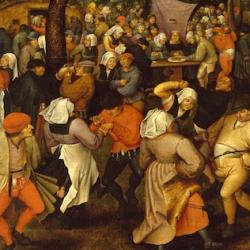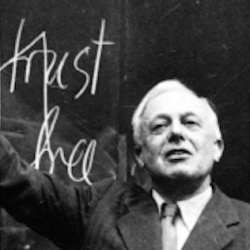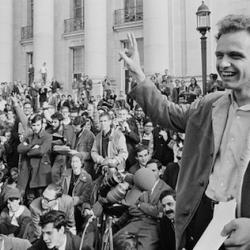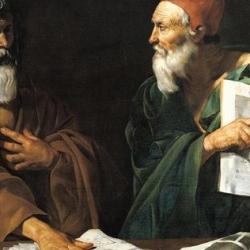Rosenstock-Huessy’s essay “Man Must Teach” begins as an analysis of Augustine’s dialogue with his son Adeodatus, the De Magistro, and then broadens out to a treatment of teaching as a paradigmatic social relation, as well as a treatment of the social construction of time. One of the key moves in Augustine’s dialogue, Rosenstock-Huessy says, is the challenge it poses to dialogue itself, for Augustine insists that the true dialogue cannot be merely dual, but must include a third, the Divine Teacher, who takes dialogue out of our hands.
Typically, Rosenstock begins by examining the specific circumstances in which the dialogue took place. Augustine and Adeodatus both had been recently baptized, which complicated an already complex social relation between them: The two are father and illegitimate son, now co-converts, but also teacher and disciple. Augustine explicitly raises the question in the dialogue about the right that he has to teach his own son: Does biology give him a claim to teach? He points out that the question of the teacher is ignored in most modern discussions of education; it is as if teachers are available, preformed, by the dozens, and the only problem is to determine the curriculum and deal with the students. There is no reciprocity in this vision of teaching; it is not a social event, since there is no correspondence between teacher and student. Rosenstock concludes that “we, like Augustine, are compelled to teach by our own life’s forces,” not by expertise, biology, the State, or any other external factor. Teaching is a fundamental, irreducible social reality, in important ways the fundamental social reality.
Another issue often ignored in modern education, but explicitly treated by Augustine, is that of time. Augustine meditated on time at length, and already recognized the difficulties of conceiving time that moderns have elaborated. The problem is that we can’t examine time because our thinking about time takes time. There is no way to step aside and examine time in a timeless way. Further, teaching takes time, and the time of teaching is a particular quality of time. Teaching requires a coordination of the schedules of students and teachers; they have to show up in the classroom at the same time. But they don’t show up as “contemporaries” but as “distemproaries.” The teacher is always “older,” if not in actual age at least in his exposure to the material; the student is always “younger” because he has never been exposed to the material or because he has not been exposed to it so deeply as the teacher. (Rosenstock-Huessy suggestively comments that “old” and “young” are not biological but social facts.)
The reality of teaching is a sign that time can be synchronized, and old/past and young/future can be harmonized in a third type of time, the time of the classroom. Distemporaries can live together, Augustine says, only “if they admit that they form a succession, if they affirm their quality of belonging to different times.” This mutual recognition is what forms the present time. The present, whether in the classroom or anywhere else, is not natural; naturally, the “present” is over as soon as we’ve uttered the word. The present is a social fact, a social construct, the fruit of the efforts of the old and young to coordinate their distemporaneity.
An analysis of the 14 books of De Magistro leads Rosenstock to the insight that the book breaks in two halves, and he characterizes the first half as “play” and the second as “serious” or “struggle.” This, he goes on to say, is the fundamental dualism of life and of education, even of liturgy: “the church holds that the liturgy is a play of humanity in the face of their Father. In Heaven and so far as we are in heaven, we play; on earth, and in so far as we must work out our salvation, we struggle.” The division of human life is not between theory and practice; theory is struggle if it is serious, though thought can also be playful.
This dualism of play and struggle overlaps the temporal dualism of young and old, future and past, and of student and teacher: “The student plays, the teacher struggles with the truth” and “The past though past is serious. The future though approaching can still be played with.” The teacher has struggled to get to his convictions, which he presents to students who have not engaged in that kind of struggle. They receive them as “ideas” to be played with, tested, tried, toyed with. The goal of education is to shift the level of thought, so that the student comes to the convictions to which the teacher has struggled. To do this, the teacher must conviction to the student in the form of play; the good teacher “begins with a joke and ends with a challenge.” And the process must work the other direction as well, “the student must be made aware that the teacher is in earnest and that he, too, one day, will have to be in earnest.” The mechanism for accomplishing this, the “transformer,” is the meeting of old and young in the present of the classroom.
This can only happen if the teacher is not a mind, intellect, or expert, but a soul: “the teacher is torn between his duties to the truth and his love for the pupil. AND WE CALL ‘SOUL’ THE POWER WHICH CAN TOWER OVER OUR TORNTOPIECESHOOD BETWEEN CONTRADICTORY TENDENCIES IN US. The soul is the power to forbear conflict. The conflict which the teacher takes upon himself lies between his life in his own time and the survival of his thought beyond his own time.” Teaching takes place, to use other terms only through faith, hope, and love: “Faith is indispensable on the side of the Student before he can understand. Love is required on the side of the Teacher who must take an interest in the growth of the Student.” Out of love for the student, the teacher engages in a kind of self-sacrifice, giving up some of the “plasticity” of youth to make himself old; the teacher must teach with conviction in order to help the student, and he can do this only if some options have been ruled out, only if he has advanced beyond play through struggle. The meeting of the faith of the student and the love of the teacher is the common spirit of hope, which should animate the classroom.
He elaborates the links between distemporaneity, the theological virtues, and teaching in a final section. Age, he says, is formation; youth is shapelessness. To become old is a form of dying, a dying to various possibilities and plasticities that are still open options for the young. To become old is to be acquainted with death. A teacher renounces his youthful play, as I’ve suggested, for the sake of his students; he always seems old to his students even when he’s younger than they are. In reward for this renunciation, he is enabled to reach past his own death and affect a future that he will never enter: “Man . . . wants to determine the future. One form of determining the future is teaching.” This “forwardizing force” is the driving force of teaching, a force that Rosenstock-Huessy also links with love. Students, on the other hand, are driven by a “backwardizing” force: They seek to penetrate past the beginning of their lives, to hang out with those who had determined the past. Teachers throw out a feeler to the future, students a feeler to the past. When students learn of what determined the past, they are capable of determining the past, not merely being determined by it. When forwardizing teachers and backwardizing students come together, they form a “body of time,” a socially formed present. Thus, to repeat, the present is a social formation, not a natural one.
This present is the creation of the social energies of faith, hope and love: “The past means a before-my-time background, to be conquered by faith. The future means an after-my-life-time to be conquered by love. The timeless present is based on the common hopes of distemporaries that by pooling their time sense, they might become contemporaries of one standstill-present.” In the absence of faith, hope, and love, the future and past haunt us with fears. Hence, psychoanalysis fills us with dread of the consequences of our childhood; the formless future is terrifying. Only through faith, hope, and love, united in teaching and learning in the socially constructed present, is time conquered.















